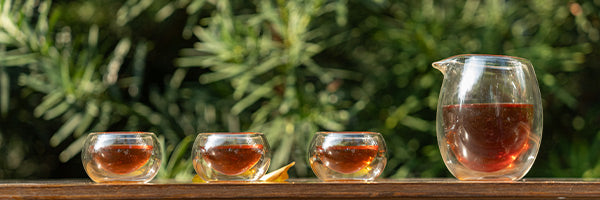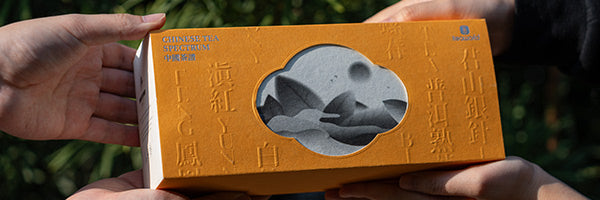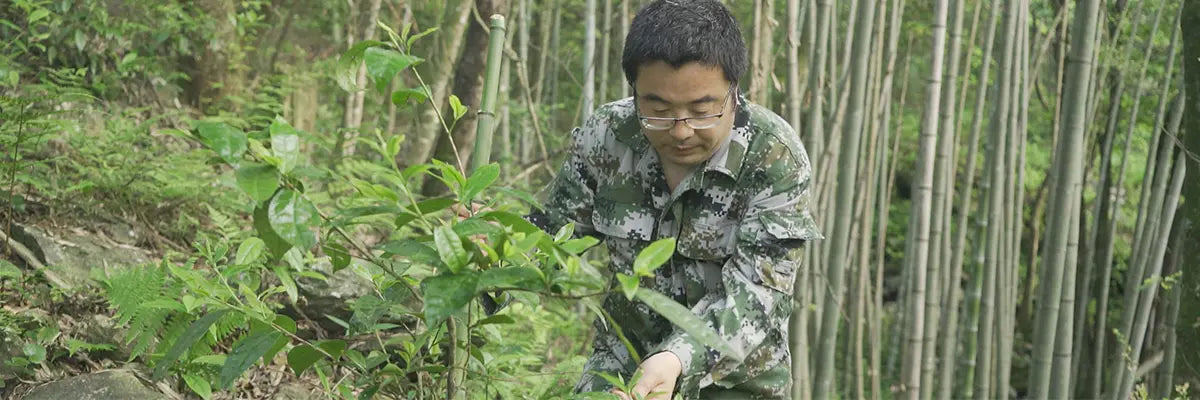Чай, с его многовековым наследием и захватывающим разнообразием вкусов, преодолел культурные границы и стал всемирным напитком выбора. Когда любители чая отправляются в путешествие в поисках идеальной чашки, их ждет кардинальное решение: листовой чай или чай в пакетиках? Это всеобъемлющее руководство раскрывает тайны мира чая, проливая свет на преимущества листового чая и предлагая экспертные идеи для руководства вашими покупками.
Что такое листовой чай?
Листовой чай относится к цельным чайным листьям и почкам, которые были тщательно собраны вручную, обработаны и высушены, но не измельчены на сломанные кусочки. Он продается без упаковки, что позволяет листьям оставаться целыми. Листовой чай сохраняет больше вкусовых соединений по сравнению с чайными пакетиками, которые могут содержать фаннинги (кусочки листьев) или пыль.

История чайных пакетиков
В отличие от общепринятого мнения, чай пили рассыпным на протяжении почти всей его истории. Чайный пакетик не использовался последние 100 лет или около того. Согласно наиболее правдоподобному сценарию, он был создан случайно. В 1908 году Томас Салливан, американский торговец чаем, расфасовал чай в одноразовые пакетики. Однако покупатель совершил ошибку, окунув весь пакетик в горячую воду. Это был первый чайный пакетик.
Крупные чайные компании начали обнаруживать, насколько быстрее это делает заваривание чашки чая, и вскоре заваривание чая в пакетиках стало стандартной практикой. Когда чай производился в пакетиках, это также позволило массово производить листья более низкого качества для потребителей, которых больше заботило удобство.
Из чего сделаны чайные пакетики?
Фильтровальная бумага, обычно получаемая из растительных волокон или древесной массы, используется для изготовления чайных пакетиков. Кроме того, некоторые чайные пакетики могут быть сделаны из шелка или нейлона на основе кукурузного крахмала, которые являются биоразлагаемыми или компостируемыми материалами. Но важно помнить, что не все чайные пакетики можно компостировать или биоразлагать, поскольку некоторые из них могут содержать синтетические материалы, такие как нейлон или полипропилен.
Каковы основные различия между листовым чаем и чаем в пакетиках?
На фундаментальном уровне листовой чай состоит из настоящих чайных листьев, которые не упакованы, тогда как чайные пакетики содержат измельченные частицы чая или фаннинги, упакованные в фильтр-пакет. Эта разница в формуле приводит к некоторым ключевым различиям между ними:
Качество ингредиентов
Чайные пакетики часто содержат низкокачественную чайную пыль, веерные отбросы и даже такие ингредиенты, как цветы, специи или ароматизаторы , которые расширяют фактическое содержание чая. Между тем, листовой чай содержит исключительно цельные чайные листья без добавок или наполнителей. Листья, используемые в листовом чае, обычно берутся с верхушки чайного куста, в которых содержится более высокая концентрация ценных питательных веществ и антиоксидантов по сравнению с более мелкими, нижними листьями, используемыми в пакетированных сортах.

Вкус и аромат
Целые листья полностью раскрываются при заваривании, высвобождая более полный спектр вкусовых соединений и ароматических масел для более тонкого, сложного вкуса, который выявляет отличительный характер каждого сорта чая. Для сравнения, пакетированный чай может иметь более слабый, более однородный профиль вкуса из-за более мелких частиц, которые резко завариваются.
Контроль закручивания
Листовой чай позволяет регулировать время заваривания, температуру и количество используемых листьев в зависимости от личных предпочтений. Чайные пакетики обеспечивают стандартизированную, но менее настраиваемую крепость. С листовым чаем можно точно настроить каждый параметр, чтобы максимизировать вкус.
Меньше отходов
Поскольку листья удаляются из воды после заваривания, а не выбрасываются весь пакетик, рассыпной лист создает значительно меньше мусора. Чайные пакетики содержат небиоразлагаемые пластиковые и алюминиевые материалы, которые разлагаются на свалках столетиями.
Экономия средств
Хотя первоначальные затраты на чай в рассыпном виде могут показаться выше, из одной партии листьев можно сделать несколько заварок по сравнению с одноразовым использованием пакетиков. Это делает рассыпной чай более выгодным вложением денег, особенно при использовании качественных листьев.
Эстетическая привлекательность
Наблюдение за тем, как листья разворачиваются и завариваются в чайнике, — визуально увлекательный процесс, в отличие от стандартного метода погружения чайных пакетиков. Это делает рассыпной чай более медитативным и захватывающим опытом чаепития.
Поднимите свое чайное путешествие на новый уровень с помощью листового черного чая! >>>
Почему листовой чай лучше, чем чай в пакетиках
Листовой чай имеет ряд преимуществ перед пакетированным чаем, что делает его предпочтительным выбором среди любителей чая. Вот несколько причин, по которым листовой чай часто считается лучше пакетированного:
1.Качество листьев:
●Рассыпной чай: Рассыпной чай изготавливается из целых или частично целых листьев, что обеспечивает более качественный продукт. Листья имеют больше места для раскрытия во время заваривания, что позволяет воде взаимодействовать со всей поверхностью. Это приводит к более ароматной и вкусной чашке чая.
●Чайные пакетики: Чайные пакетики часто содержат сломанные чайные листья или пыль, что может ухудшить общее качество и вкус чая. Более мелкие частицы могут не дать той же глубины и сложности, что и листовой чай.
2.Вкусовой профиль:
●Рассыпной чай: Нетронутая природа рассыпных листьев позволяет получить более тонкий вкусовой профиль. Каждый тип чая имеет свой собственный отличительный вкус, и рассыпные чаи полностью сохраняют эти вкусы. Любители чая могут ощутить весь спектр нот, от верхних до нижних, с каждым глотком.
●Чайные пакетики: Чайные пакетики могут содержать низкосортные чайные листья или фаннинги, которые являются сломанными фрагментами. Это может привести к менее сложному и менее ароматному напитку по сравнению с листовым чаем.
3.Аромат:
●Листовой чай: эфирные масла и летучие соединения, присутствующие в цельных листьях, способствуют более насыщенному аромату. Процесс заваривания листовых листьев высвобождает эти ароматические соединения, обеспечивая ароматный и восхитительный опыт.
●Чайные пакетики: Из-за ограничений чайных пакетиков высвобождение ароматов может быть ограничено. Аромат в чайных пакетиках может быть менее выраженным и ярким по сравнению с открытой, экспансивной природой листового чая.
4. Церемониальный и ритуальный опыт:
●Листовой чай: Заваривание листового чая может стать ритуальным опытом, особенно при использовании традиционных методов заваривания, таких как гунфу ча. Это добавляет церемониальный аспект приготовлению чая, усиливая общее наслаждение.
●Чайные пакетики: Несмотря на удобство, чайные пакетики могут не обладать ритуальным аспектом и сенсорным взаимодействием, которые возникают при приготовлении и наслаждении листовым чаем.

Плюсы и минусы листового чая
Преимущества листового чая
1. Листовой чай обладает многочисленными преимуществами, которые делают его предпочтительным выбором для любителей чая. Во-первых, листовой чай известен своим превосходным качеством. В отличие от чайных пакетиков, которые часто содержат сломанные или низкосортные чайные листья, листовой чай состоит из целых, не сломанных листьев. Это обеспечивает более крепкий вкус, улучшенный аромат и более насыщенный общий опыт чаепития.
2. Во-вторых, листовой чай обеспечивает больший контроль и настройку. С листовым чаем у вас есть свобода регулировать такие факторы, как температура воды, время заваривания и соотношение чая и воды в соответствии с вашими личными вкусовыми предпочтениями. Эта гибкость позволяет вам экспериментировать и создавать чашку чая, которая идеально подходит вам. Кроме того, листовой чай можно заваривать несколько раз, предлагая несколько заварок и более экономичный опыт чаепития.
Минусы листового чая
1.Один из недостатков листового чая заключается в том, что его приготовление требует больше времени и оборудования по сравнению с простым замачиванием чайного пакетика. Вам понадобится чайник, чтобы вскипятить воду, заварочный чайник или заварник, чтобы хранить листы, и вы должны отмерить необходимое количество листьев для каждой заварки. Процесс приготовления занимает несколько минут, пока вы нагреваете воду, завариваете листья и моете всю посуду после этого.
2.Кроме того, рассыпной чай представляет небольшой риск утечки из заварника и попадания в заваренный чай, что может повлиять на вкус. Этого не происходит с чайными пакетиками, где листья надежно запечатаны внутри. Для хранения рассыпного чая требуются герметичные контейнеры, чтобы сушеные листья не стали черствыми быстрее, чем пакетированные альтернативы. Особую осторожность следует проявлять при очистке основных инструментов для рассыпного чая, таких как чайники и заварники.
Насладитесь изысканными вкусами листового чая Улун! >>>
Плюсы и минусы чайных пакетиков
Плюсы использования чайных пакетиков
1. Чайные пакетики обладают рядом преимуществ, которые делают их удобным и популярным выбором для любителей чая. Во-первых, чайные пакетики удобны и просты в использовании. Они устраняют необходимость отмерять листовой чай, что делает их быстрым и удобным вариантом для одной чашки чая. Чайные пакетики также портативны, что делает их идеальными для любителей чая на ходу, которые могут легко носить их в своих сумках или карманах.
2. Во-вторых, чайные пакетики, как правило, более доступны и широко распространены, чем листовой чай. Их можно найти в большинстве продуктовых магазинов, что делает их удобными для людей, которые покупают свои любимые сорта чая без необходимости посещать специализированные чайные магазины или делать заказы онлайн. Кроме того, чайные пакетики часто бывают с различными вкусами и смесями, удовлетворяя широкий спектр вкусовых предпочтений. Эта доступность и разнообразие делают чайные пакетики удобным и универсальным вариантом для любителей чая.
Минусы использования чайных пакетиков
1. Хотя чайные пакетики удобны, у них также есть несколько недостатков. Во-первых, чайные пакетики часто содержат чай более низкого качества по сравнению с листовым чаем. Обычно они заполнены чайной пылью или фаннингами, которые представляют собой сломанные и более мелкие чайные листья. Это может привести к менее вкусной и ароматной чашке чая по сравнению с целыми листьями, используемыми в листовом чае.
2. Во-вторых, чайные пакетики могут ограничить контроль над процессом заваривания. Замкнутое пространство внутри чайного пакетика ограничивает расширение и циркуляцию чайных листьев, что может повлиять на извлечение вкусов и ароматов. Это может привести к более слабой или менее нюансированной чашке чая. Кроме того, материалы, используемые в некоторых чайных пакетиках, такие как отбеленная бумага или нейлон, могут придавать чаю нежелательные вкусы или химикаты.

Виды листового чая
1. Зеленый чай:
Зеленый чай известен своими свежими и травяными нотками, которые возникают из-за минимального окисления, которому он подвергается во время обработки. Такие сорта, как Dragon Well из Китая и Sencha из Японии, предлагают широкий спектр вкусов, от растительного до умами и слегка орехового. Dragon Well имеет тенденцию к более поджаренным нотам с глубоким вкусом, в то время как sencha может похвастаться ярким, сладким ароматом.
2. Черный чай:
Черный чай — популярный напиток, известный своим крепким вкусом и тонизирующими свойствами. Одним из примечательных сортов является черный чай Yingde , происходящий из региона Yingde в провинции Гуандун, Китай. Известный своим превосходным качеством и особым вкусом, черный чай Yingde характеризуется богатым солодовым вкусом и ноткой сладости. Его пленительный аромат и глубокий янтарный настой делают его любимым выбором для любителей чая, ищущих смелую и удовлетворяющую чашку черного чая.
3. Чай Улун:
Как полуокисленный чай, улун занимает промежуточное положение между зеленым и черным чаем. Уровень окисления может сильно варьироваться, от едва окисленного до почти черного. Два известных сорта улуна — это Те Гуань Инь с его ароматами орхидеи и легкой терпкостью, и китайский Фуцзянь Да Хун Пао, известный своим сладким цветочным ароматом. Улуны искусно демонстрируют сложное взаимодействие вкуса и окисления.
4. Белый чай:
Белый чай — наименее обработанный из всех настоящих чаев. Молодые почки и листовые сорта, такие как Silver Needle и Bai Mu Dan, отличаются тонкой сладостью и нежными цветочными и растительными ароматами. Ценимые за свою тонкую сложность, белые чаи мягко настаиваются, чтобы выявить их утонченные качества.
5. Чай Пуэр:
Выдержанные и ферментированные чаи пуэр демонстрируют большой потенциал созревания. Шэн или «сырой» пуэр естественным образом ферментируется с течением времени, приобретая глубокие землистые и грибные ноты. Шу или «приготовленный» пуэр подвергается быстрой ферментации, в результате чего получается темный напиток с древесными ароматами. Оба вознаграждают созерцательное заваривание и выдержку.
Понимание сортов чая
1.Целый лист против сломанного листа:
Цельнолистовой чай часто указывает на более высокий сорт, так как листья не повреждены и сохраняют свои эфирные масла. Ломаные листовые чаи, хотя и предлагают восхитительные ощущения, могут иметь другой профиль вкуса из-за повышенного окисления во время обработки. Более мелкие кусочки ломаных листовых чаев могут придать более смелый, крепкий вкус по сравнению с цельными листьями, которые имеют более легкий настой.
2.Системы оценивания:
В различных регионах производства чая используются системы оценки, которые классифицируют чай на основе таких факторов, как размер листа, внешний вид, аромат и часть растения, с которого был собран лист. В Китае и Японии используются числовые шкалы для оценки степени цельности и качества, одна из которых является лучшей. В других местах используются буквы — класс FBOP в Индии оценивает размер и качество. Ознакомьтесь с этими системами, чтобы сделать осознанный выбор.
3. Однородное или смешанное происхождение:
Чай одного происхождения позволяет вам глубоко прочувствовать терруар места, где он был выращен. Исследуйте отдельные поместья или регионы, чтобы открыть для себя их уникальные характеристики. Смеси объединяют листья из разных регионов, чтобы создать слои вкуса, но не передают то же самое ощущение места. Смеси позволяют создавать интересные сочетания вкусов, в то время как чай одного происхождения предлагает чистоту и сложность для раскрытия.
4.Отзывы и репутация:
Чтение отзывов и изучение репутации производителя чая дает более глубокое понимание сорта. Мастера с высокими стандартами производят превосходные сорта. Источники ингредиентов и особые методы обработки также влияют на качество. Со временем вы научитесь определять тонкие признаки, указывающие на сорт, от внешнего вида до заваривания. Понимание сортов поможет вам выбрать чай, который соответствует вашим предпочтениям.

Покупка лучшего листового чая – руководство
Листовой чай — популярный выбор среди любителей чая, известный своим превосходным качеством и вкусом по сравнению с пакетированным чаем. Однако при таком количестве разновидностей и вариантов покупка лучшего листового чая может оказаться непосильной задачей, особенно для новичков. Если вы новичок в листовом чае или просто хотите попробовать разные виды чая, то пробник чая может стать отличным вариантом.
1. Определите свой предпочтительный вкус
Прежде всего, вам нужно определить свой предпочтительный вкус чая. Листовой чай бывает разных сортов, таких как зеленый чай, черный чай, белый чай, улун и т. д., каждый из которых обладает своим уникальным вкусом и характеристиками. Если вам нравится легкий и нежный вкус, вы можете выбрать зеленый или белый чай; если вы предпочитаете более насыщенный вкус, черный или улун будут хорошим выбором. Кроме того, вы также можете учитывать уровень кофеина в чае, так как некоторые чаи содержат больше кофеина, чем другие.
2.Оцените качество чая.
При покупке листового чая важно обращать внимание на качество чая. Листовой чай обычно считается более качественным, чем чай в пакетиках, так как листья не ломаются и сохраняют больше натуральных масел и ароматов. Ищите чай, собранный вручную и полученный из надежных чайных плантаций. Вы также можете поискать сертификаты, такие как Fair Trade или Organic, чтобы убедиться, что чай произведен этично и устойчиво.
3.Проверьте свежесть чая.
Свежесть чая имеет решающее значение для сохранения его качества и вкуса. При покупке листового чая обязательно проверьте дату упаковки или срок годности, чтобы убедиться, что чай свежий. Рекомендуется употребить листовой чай в течение года с даты упаковки для лучшего вкуса.
4.Узнайте происхождение чая
Происхождение чая может играть значительную роль в его вкусе и качестве. В разных регионах разные условия выращивания и методы обработки, что приводит к уникальным вкусам и характеристикам. Например, китайский зеленый чай известен своим нежным и травянистым вкусом, а индийский черный чай — ярким и крепким. Знание происхождения чая может помочь вам выбрать чай, который соответствует вашим вкусовым предпочтениям.
5.Учитывайте стоимость и количество.
Листовой чай может стоить по-разному в зависимости от качества, происхождения и типа чая. Важно учесть свой бюджет и то, сколько чая вы хотите купить. Листовой чай обычно продается в унциях, поэтому обязательно проверьте количество перед покупкой. Некоторые известные продавцы, такие как iTeaworld, также предлагают пробники чая , которые могут быть хорошим вариантом, если вы хотите попробовать разные виды чая, не покупая большое количество.
В заключение, покупка листового чая требует некоторых знаний и размышлений. Следуя этим рекомендациям, вы сможете выбрать высококачественный чай, который соответствует вашему вкусу и бюджету. Не забывайте хранить листовой чай правильно, в герметичном контейнере вдали от тепла и влаги, чтобы сохранить его свежесть и вкус. Наслаждайтесь чашкой листового чая!

Основы пивоварения
Заваривание листового чая — древнее искусство, требующее внимания к деталям и понимания тонкостей вкуса. В отличие от чайных пакетиков, которые часто содержат сломанные листья или пыль, листовой чай предлагает более богатый и сложный вкусовой профиль. Повысьте свои впечатления от чаепития с помощью этих важных советов по завариванию, которые учитывают уникальные качества листового чая.
1. Начните с качественного листового чая:
●Путь к идеальной чашке чая начинается с самих листьев. Выбирайте высококачественный листовой чай от надежных поставщиков. Целые или частично цельные листья обеспечивают более тонкий и ароматный напиток.
2. Точное измерение для обеспечения постоянства:
●Точные измерения имеют решающее значение для последовательности приготовления чая. Используйте чайную ложку, чтобы отмерить нужное количество листьев, обычно около одной чайной ложки на 8 унций воды. Отрегулируйте в зависимости от типа чая и ваших вкусовых предпочтений.
3. Освоение температуры воды:
●Различные виды чая требуют определенной температуры воды для извлечения их оптимальных вкусов. Инвестируйте в чайник с переменной температурой, чтобы добиться точности:
●Белый и зеленый чай : 160–185°F (71–85°C)
●Чай улун: 185–205°F (85–96°C)
●Черный и травяной чай: 200–212°F (93–100°C)
4. Выберите правильную посуду для заваривания чая:
●Выбор чайной посуды существенно влияет на процесс заваривания. Используйте чайник или заварник, который позволяет листьям раскрываться и свободно взаимодействовать с водой. Для некоторых видов чая рассмотрите гайвань или чайник из исинской глины для более контролируемого заваривания.
5. Оптимизация времени настаивания:
●Регулировка времени заваривания — это искусство, которое может сделать или испортить ваш чай. Экспериментируйте с разной продолжительностью, чтобы найти золотую середину для выбранного вами чая. Более короткое время дает более легкий напиток, а более длительное время усиливает вкус.
6. Фильтрованная вода для чистоты:
●Качество воды напрямую влияет на вкус вашего чая. Используйте фильтрованную воду, чтобы избежать примесей, которые могут повлиять на вкус чая. Сбалансированное содержание минералов в воде улучшает общее впечатление от заваривания.
7. Промывание листьев:
●Некоторые чаи выигрывают от быстрого ополаскивания перед первым завариванием. Залейте листья горячей водой, а затем слейте ее. Это помогает пробудить листья и удалить остатки пыли или примесей.
8. Служение с ритуалом:
●Налейте заваренный чай в чайник или прямо в чашки, соблюдая ритуал подачи чая. Этот шаг добавляет сенсорный элемент к опыту, позволяя вам оценить цвет и аромат чая.
Заваривание листового чая — это искусство, которое призывает к исследованию и открытию. С этими важными советами вы на пути к освоению тонкостей заваривания листового чая и открытию мира вкусов в каждой чашке. Итак, соберите свои любимые листовые листья, подготовьте сцену с помощью правильной чайной посуды и отправляйтесь в путешествие чувственного наслаждения с каждым изысканным завариванием.
Поднимите подарок на новый уровень с нашими тщательно подобранными подарочными наборами для чая! >>>

Как хранить чай
Правильное хранение необходимо для сохранения вкуса, аромата и качества вашего чая. Независимо от того, являетесь ли вы любителем чая или преданным энтузиастом, соблюдение этих рекомендаций гарантирует, что ваши чайные листья сохранят свою свежесть с течением времени.
1. Герметичные контейнеры: Храните чай в герметичных контейнерах, чтобы защитить его от воздуха, влаги и внешних запахов. Это сохраняет целостность чая и не дает ему впитывать нежелательные запахи.
2. Прохлада, темнота и сухость: выберите прохладное, темное и сухое место для хранения. Воздействие тепла и солнечного света может ухудшить вкус и аромат чайных листьев. Держите чай вдали от прямых солнечных лучей или источников тепла.
3. Непрозрачные контейнеры: выбирайте непрозрачные контейнеры, чтобы защитить чай от света, так как длительное воздействие может привести к ухудшению вкуса. Избегайте прозрачных контейнеров, которые позволяют свету ухудшать качество чая.
4. Герметичные пакеты: Если чай поставляется в герметичных пакетах, запечатывайте их после каждого использования. Удаление лишнего воздуха перед запечатыванием минимизирует воздействие и помогает сохранить свежесть.
5. Отделите сильнопахнущие чаи: Храните сильнопахнущие чаи отдельно, чтобы предотвратить передачу ароматов. Храните ароматизированные или ароматизированные чаи в разных контейнерах, чтобы сохранить различные характеристики.
6. Избегайте охлаждения: воздержитесь от охлаждения чая, так как колебания температуры и потенциальная влажность могут привести к образованию конденсата, что отрицательно скажется на листьях.
Соблюдая эти правила хранения, вы сможете продлить срок годности вашего чая и наслаждаться с каждой чашкой его богатым и изысканным вкусом, характерным для высококачественного чая.
Часто задаваемые вопросы о листовом чае и чайных пакетиках:
1.Есть ли больше вариантов вкусов листового чая?
Да, листовой чай предлагает широкий выбор вкусов. С листовым чаем вы можете исследовать различные виды чая, смеси и даже создавать свои собственные смеси. Чайные пакетики обычно имеют более ограниченный выбор вкусов.
2. Являются ли листовые чаи более полезными для здоровья, чем чай в пакетиках?
Листовой чай, как правило, имеет более высокий уровень антиоксидантов и полифенолов по сравнению с пакетированным чаем. Эти полезные соединения часто более концентрированы в листовом чае из-за использования цельных листьев.
3.Можно ли использовать листовой чай в пакетиках?
Да, вы можете использовать пустые чайные пакетики или одноразовые чайные фильтры для заваривания листового чая. Это позволяет вам наслаждаться удобством чайных пакетиков, продолжая использовать ваш любимый листовой чай.
4. Листовой чай дороже пакетированного?
Листовой чай может варьироваться в цене в зависимости от таких факторов, как качество, происхождение и редкость. Хотя некоторые листовые чаи могут быть дороже, чем чай в пакетиках, есть и доступные варианты. Стоимость часто оправдывается превосходным качеством и вкусовыми ощущениями, которые предлагает листовой чай.
5.Существуют ли какие-либо особые методы заваривания листового чая?
Заваривание листового чая обычно подразумевает использование заварника, чайника или других приспособлений для заваривания. Время заваривания, температура воды и соотношение чая и воды могут варьироваться в зависимости от типа чая и личных предпочтений.
6.Есть ли какая-либо польза для здоровья от чайных пакетиков?
Чайные пакетики, как и листовой чай, могут принести пользу здоровью благодаря антиоксидантам и полифенолам, присутствующим в чае. Однако конкретные преимущества для здоровья могут различаться в зависимости от типа и качества используемого чая.
Помните, что рассыпной чай обеспечивает более индивидуальный и высококачественный процесс чаепития по сравнению с чайными пакетиками.
Почувствуйте сущность природы с нашим соблазнительным дегустатором зеленого чая! >>>

Последнее слово о листовом чае и пакетированном чае
Пакетики чая могут быть удобным способом познакомить людей с миром чая в особых случаях. С другой стороны, вы откроете для себя мир энтузиазма и исследований, когда возьметесь за задачу заваривания листового чая. Множество уникальных чаев ждут вас, маня вас открыть их заманчивые ароматы и вкусы.
Вы можете погрузиться в искусство приготовления чая, экспериментируя с пропорциями и процессами заваривания листового чая , превращая себя в алхимика. Поиск идеальной смеси, которая придется вам по вкусу, превращает каждый глоток в приключение. Примите очарование листового чая и позвольте ему разжечь в вас желание, которое выходит за рамки нормы, выводя ваше чаепитие на новый и удивительный уровень.












































































